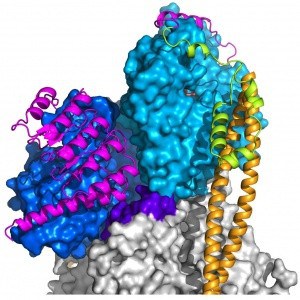Actin is the most abundant protein in the body, and when you look more closely at its fundamental role in life, it’s easy to see why. It is the basis of most movement in the body, and all cells and components within them have the capacity to move: muscle contracting, heart beating, blood clotting, and nerve cells communicating, among many other functions. And, movement can turn harmful when cancer cells break away from tumors to set up shop in distant tissues.
Adding to the growing fundamental understanding of the machinery of muscle cells, a group of biophysicists from the Perelman School of Medicine at the University of Pennsylvania describe in the journal Science this week – in minute detail — how actin filaments are stabilized at one of their ends to form a basic muscle structure called the sarcomere.
With the help of many other proteins, actin molecules polymerize to form filaments that give rise to structures of many different shapes. The actin filaments have a polarity, with a plus and minus end, reflecting their natural tendency to gain or lose subunits when not stabilized.
Actin is one of the two major proteins (together with myosin) that form the sarcomere — the contractile structures of cardiac, skeletal, and smooth muscle cells. In sarcomeres, actin filaments are stabilized at both ends by capping proteins. At the minus end of the filament, the universal capping protein is tropomodulin.
“While the existence of this protein has been known for almost 30 years, we still did not know how it actually works,” says senior author Roberto Dominguez, PhD, professor of Physiology. His lab is dedicated to deciphering the fundamental mechanisms of proteins responsible for movement, and how these components fit together at the atomic level.
“We describe how tropomodulin interacts with the slow-growing end of actin filaments,” says coauthor Yadaiah Madasu, PhD, a postdoctoral fellow in the Dominquez lab. “From a clinical point of view, we know that mutations in tropomodulin can trigger an accumulation of irregular actin filament bundles, which contribute to nemaline myopathy or other skeletal muscle disorders typified by delayed motor development and muscle weakness.”
“The lack of structural information for the minus end of the actin filament severely limits our understanding of how tropomodulin caps actin,” says Dominguez. The team described atomic crystal structures of tropomodulin complexes with actin. The structures and biochemical analysis of engineered tropomodulin variants show how one tropomodulin molecule winds around the minus end of an actin filament, making highly specific interactions with three actin subunits and two tropomyosin molecules (another protein characteristic of muscle sarcomeres) on each side of the actin filament. The detailed picture emerging from this study will help shed light on how mutations in tropomodulin, actin, and tropomysin can cause heart disorders.


